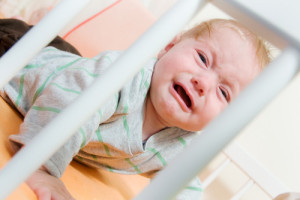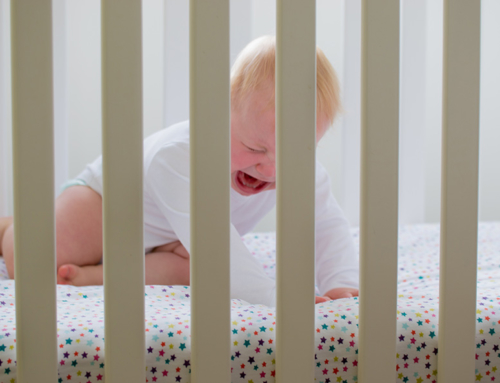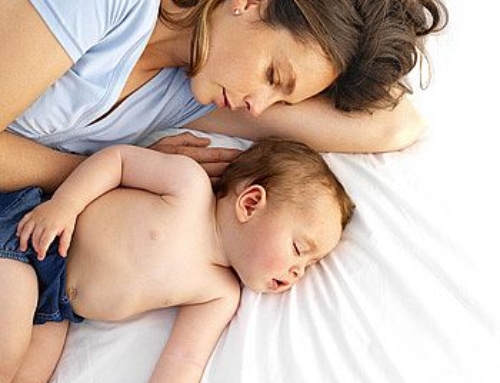
Source: Unknown
Note: The following submission was sent to me via email by a mother who has asked to remain Anonymous. The following is her own experience in her own words. I will share a few comments at the end as well, but ask that you read her story first.
I just finished reading your article on Responsive Settling. We live in Australia and can add another voice to this conversation…
A family friend who previously assisted families with responsive settling and sleep volunteered to help us train our 4.5 month-old baby to sleep in his cot, and possibly without a dummy. The only reason I/we considered this path and support was because my back was no longer allowing me to carry him or rock him to sleep. As a reflux baby, I quite literally had spent the past almost 5 months carrying him upright in an effort to minimise his vomiting. Needless to say, had I truly understood what my friend had intended, I would have politely declined the help. As it was, I had to leave the house during the day for three days because I was considered a risk to the success of the training. I fully admitted that if I were to listen to my baby cry and scream for hours, then I would 100% pick him up and calm him. But given I did truly need change, I acquiesced.
My mum and my husband undertook the bulk of the settling and resettling for the first three days. The shush pat method was employed, and he was rotated in his cot like a rotisserie chicken to help him find a comfortable position. All this, whilst he cried and cried and cried. My son showed some progress after 1.5 days in falling to sleep with these strategies, but woke routinely after 30 mins. Our friend then insisted, as sleep schools here do, that we continue to shush pat and re-position him until the next feed, which in practice saw them ‘resettling’ him for 1.5 hrs. He spent almost every resettle in a high state of distress. On a handful of occasions he fell asleep just on the 1.5 hr mark, out of sheer exhaustion, and was allowed to sleep.
When my turn came to sub in and start learning the new regime, I felt sick to my stomach. During the three days we had started to notice our baby become distant with us. He was no longer smiling or responding to our attempts to be social, and his voice became hoarse from crying so much. Our family friend was militant, and adamant that the routine continue. By day four, my mother and husband were showing signs of extreme personal distress. After my first ‘turn’ at settling and resettling, with the inevitable pre-sleep and resettle 1.5 hrs of crying, I stated to my mum and husband that under no circumstances could I continue with the routine.
The look of relief on their faces was palpable.
The side effects of the new regime were also beginning to show, in that my little boy would start crying as we entered his bedroom, it would escalate as we popped him on his change table, and by the time he was placed in his cot he was inconsolable. Protest cry or not, this baby of mine was in a state of hyper-vigilance and displaying heightened signs of anxiety. Not only was responsive settling NOT responsive, but the packaging within which this method was sold evoked such a high degree of stress in our little baby and in us also. It left me in a state of such distress that a visit to my trusted GP for medication support was required in the days and weeks following.
With round the clock support from my husband and mother, both my son and I have calmed and recovered some what from the trauma and farce that is responsive settling. Touted as the solution for all babies, it is yet another tool in the Parenting Machine that undermines and flat out destroys a parent’s confidence to know and respond empathically to their baby. Does it work for some babies? Sure, maybe! Perhaps Kagens low-reactive babies would respond well, though it’s likely these babies would respond to all sorts of training techniques. But in the high-reactive Bub that is my baby boy, it did not improve one iota under this methodology.
I am so angry at the ‘well meaning’ nurses and parenting experts who push these methods as the be-all and end-all. And that they have the nerve to proclaim that it is gentle or attachment based, what a crock of s**t!
Tracy here. I decided to share this when sent to me because it is one of so many stories that I have now read about the responsive settling method that is quite popular in Australia. I know that my take against it has irked some. I know that some would argue that this is not a reflection of the method and that a child that is this distressed should be picked up immediately and that this friend has it wrong. I believe that the method as it has been devised may very well reflect that. In fact, I don’t doubt that it was developed with the best of intentions and that this is not how it’s supposed to go.
The practice of it, however, does not reflect this development for far too many.
I have heard enough from so many women – many of whom who have been to the centres that are using this method run by those who established it – to know that it is how it is being practiced by many whose babies don’t immediately conform to the reduction in responsiveness that are first tried (vocal techniques, shush and pat, and so on). Although they are able to first pick up their babies when they still cry, many report after a few days that this ceases to be the case. They are told they have to be firmer and baby will “get” it. The responsive element seems to disappear in hopes of “success”.
This bring me to my major issue: Like most methods, it tries to claim it works for everyone and then doesn’t have anywhere else to go but to less responsive (or non-responsive) methods when babies don’t “comply” with the transition using the gentler starting points. Of course, as a publicly-funded program, it has to offer results and that binds those who are taking part to focus on “solutions” and one-size-fits-all ones at that.
I don’t doubt there are many women and babies who have responded to responsive settling positively and without the trauma that the author here has. However, as she mentions, I’m sure many of them are low-reactive babies to begin with. For higher-needs babies, we need to focus on better understanding of their biological needs and finding ways to work with them instead of against them.
Thanks for listening.






Unfortunately, this was my experience as well, albeit without “professional” assistance so the blame for the trauma lies solely on me. After putting himself to sleep perfectly for 6 months, my son just suddenly refused sleep without a grueling, backbreaking combo of walking/rocking/patting…so against my gut we tried sleep training. For us, it came complete with crying and trembling when we got near his bedroom door. I quit at 5 days. It was heartbreaking.
He’ll be a year old in a few weeks and I still go through the routine he needs every night. Sometimes 3 or 4 times. If I don’t, he will and has refused sleep for as much as 10 hours. My chiropractor loves it. I don’t…but I know it’s wrong not to. He just needs me.
i think it is cruel and counter-productive. people are often desperate to find a “solution”, because they are sleep-deprived, as is normal for new parents, and because there are other stressors or factors such as the physical challenge above or work pressures requiring a mum to settle the child into routine willy-nilly…but to take advantage of desperate parents and their innocent babies by marketing and implementing a trust-breaking system like this is simply cruel. better to put our efforts into more support for mothers and more flexible social and work environments and policies that do not pit parents against their own beloved offspring in such ways.
I had the exact same experience with my determined son at a public sleep school in Australia. I am so comforted to hear similar voices.